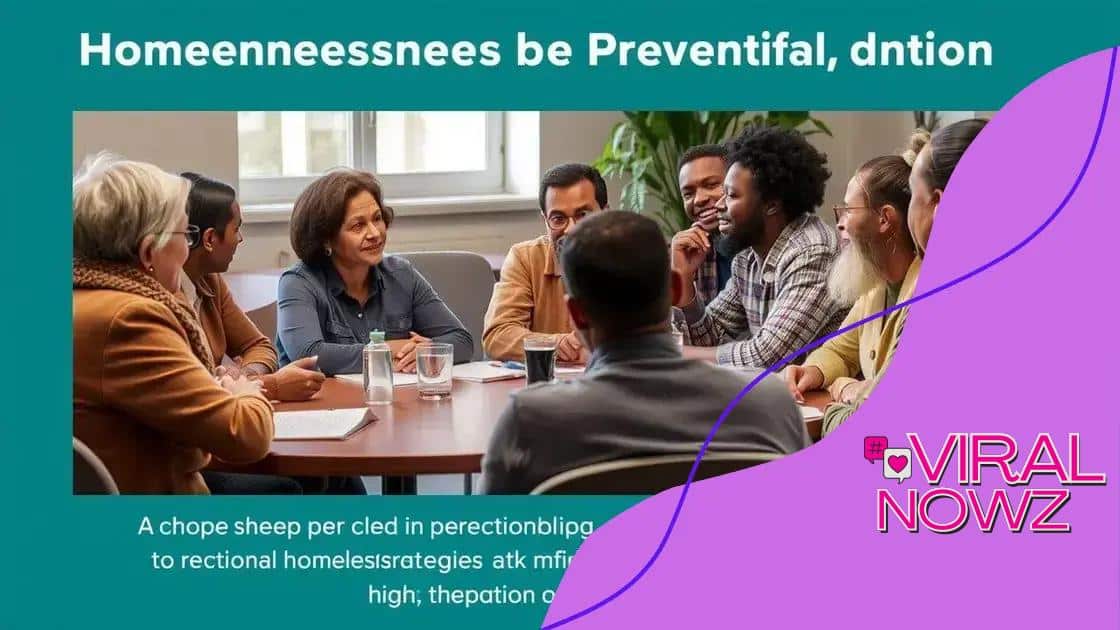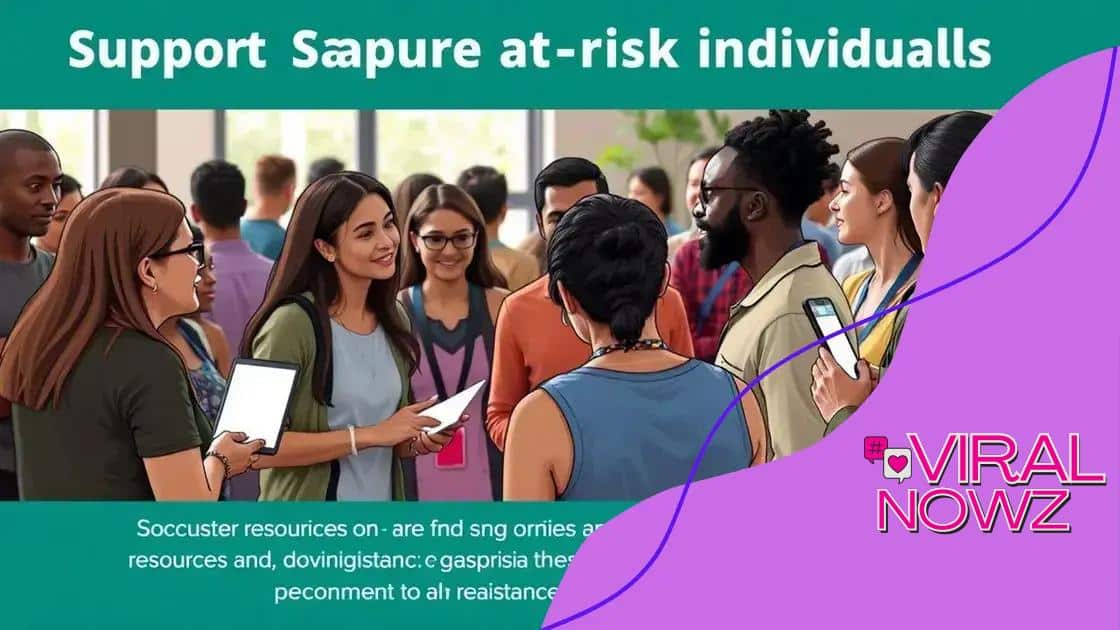Homelessness prevention strategies and initiatives you should know

Effective homelessness prevention strategies focus on community support, innovative programs, and sustainable housing solutions to provide stable living conditions for at-risk populations.
Strong homelessness prevention strategies and initiatives are crucial for keeping families and individuals off the streets. Have you ever wondered how communities can actively work to prevent homelessness? In this article, we’ll dive into the various methods and programs that make a difference.
Understanding homelessness prevention strategies
Understanding homelessness prevention strategies is essential for creating effective solutions. These strategies can help communities address the root causes of homelessness and provide support systems for individuals at risk. Knowing how these strategies work is key to fostering long-term stability.
Key Concepts of Homelessness Prevention
There are several important concepts to grasp when considering homelessness prevention. First, recognize that interventions should be timely and targeted. The earlier assistance is provided, the better the outcomes usually are. Secondly, it’s crucial to address the specific needs of different populations, such as families, veterans, or individuals with mental health challenges.
Types of Strategies
Some common strategies include:
- Financial assistance to prevent evictions.
- Access to affordable housing options.
- Counseling and support services to address mental health and addiction issues.
By combining these approaches, communities can create a comprehensive plan to help those in need. Moreover, successful homelessness prevention requires collaboration among various stakeholders, including government agencies, nonprofits, and community members.
Prevention programs can offer resources like mediation between landlords and tenants or financial planning workshops. Learning about these resources is essential for both individuals seeking help and organizations aiming to provide support. Community education and outreach can ensure that those in need are aware of their options and how to access them.
Effective initiatives for at-risk populations
Effective initiatives for at-risk populations are critical in addressing homelessness and preventing individuals from losing their homes. These initiatives are designed to cater to the unique needs of groups such as low-income families, veterans, and individuals facing mental health challenges.
Examples of Effective Initiatives
One important aspect is providing targeted services that directly benefit those most vulnerable. Some promising initiatives include:
- Rapid rehousing programs that offer temporary financial assistance and support.
- Housing-first approaches that prioritize stable housing without preconditions.
- Job training and employment services tailored for at-risk groups.
Additionally, strengthening community partnerships can enhance the effectiveness of these initiatives. Nonprofits, local governments, and businesses can collaborate to create a network of support that reflects the needs of the community. Services should be easily accessible to ensure that individuals know where to go for help.
For instance, community outreach events can help spread awareness about available resources. Educating the public about the challenges faced by at-risk populations fosters empathy and encourages more people to get involved in the support process. This way, everyone plays a part in building a more inclusive community.
Lastly, involving those affected in the planning and implementation of initiatives ensures that the strategies are truly effective and sensitive to their needs. When individuals contribute their insights, services become more tailored and supportive.
The role of community support in prevention

The role of community support in prevention is vital for effectively addressing homelessness. Community involvement fosters a sense of belonging and encourages individuals to seek help when needed. When people feel supported, they are less likely to face housing instability.
Importance of Community Networks
Community networks can provide critical resources to those at risk of homelessness. These networks often consist of local organizations, volunteers, and even neighbors. They work together to create a safety net. Many communities hold meetings and workshops to spread awareness about the importance of support. By doing so, they empower individuals to take charge of their situations.
Ways to Engage the Community
Effective ways to engage the community include:
- Organizing volunteer programs to assist at-risk individuals.
- Creating local resource guides that outline available services.
- Hosting events that bring together residents for information-sharing.
Such initiatives help create strong, supportive environments that make it easier for individuals to access necessary resources.
In addition, local businesses can also participate in supporting at-risk populations. By sponsoring programs or providing job opportunities, they contribute to a healthier economic environment. This helps reduce the likelihood of homelessness as individuals gain skills and financial independence.
Ultimately, a community-focused approach can lead to innovative solutions for homelessness prevention. Engaging all members of the community creates a broader awareness, fostering empathy and understanding. When everyone contributes, the community becomes a stronger network of support for those who need it most.
Innovative programs addressing homelessness
Innovative programs addressing homelessness have emerged as powerful tools for preventing and alleviating the issue. These programs often focus on creative solutions that meet the unique needs of individuals and families facing housing challenges. By employing out-of-the-box thinking, communities can find effective ways to sustain housing for those at risk.
Technology in Homelessness Solutions
One area where innovation shines is in the use of technology. Mobile apps now connect individuals with local resources. They can find shelters, food banks, and job opportunities in real-time. This immediate access to information can significantly impact someone’s ability to stabilize their situation quickly.
Housing First Model
Another innovative approach is the Housing First model. This strategy prioritizes providing the homeless with permanent housing without preconditions. By doing this, individuals can focus on addressing other issues, like health care or job training, without the stress of finding a place to live first.
Community-Based Initiatives
Community-based programs that involve local artists and entrepreneurs can also make a difference. These initiatives not only beautify neighborhoods but also create jobs and provide training. For example, art programs can engage homeless individuals, allowing them to express their experiences while fostering community connections.
Employing a blend of these programs enhances the support network available to those facing homelessness. Collaborations with local businesses can lead to job training and placement opportunities. This involvement helps people rebuild their lives and contributes to stronger, more cohesive communities.
Ultimately, by fostering creativity and leveraging resources, innovative programs can play a significant role in addressing the complexities of homelessness. These programs demonstrate that with the right support, individuals can regain stability and thrive.
Long-term solutions for sustainable housing
Long-term solutions for sustainable housing are essential in the fight against homelessness. These solutions can provide stable living conditions for individuals and families, ultimately fostering community resilience. Tackling the housing crisis requires thoughtful planning and collaboration among various stakeholders.
Creating Affordable Housing
One effective strategy is the development of affordable housing options. Communities can partner with developers to build new, low-cost housing. This approach can make a significant dent in the number of families facing housing instability. Additionally, maintaining existing housing is crucial. Upgrading older units can provide safe and affordable living spaces for at-risk populations.
Incorporating Green Building Practices
Incorporating green building practices in new housing developments is another key component. These practices not only reduce environmental impact but also lower utility costs, making homes more affordable in the long run. For example, using energy-efficient materials and technologies can minimize energy consumption.
Supportive Housing Models
Another vital aspect of sustainable housing is the adoption of supportive housing models. This involves providing services such as mental health support and job training alongside housing. By addressing the underlying issues that contribute to homelessness, these models can significantly improve the chances of long-term success for residents.
Engaging community members in the planning process is also essential. Public forums and discussions can help ensure that new housing developments meet the specific needs of the population. When communities are actively involved, they can advocate for solutions that promote sustainability and inclusivity.
Finally, securing consistent funding is crucial for these initiatives. Government grants, private investments, and nonprofit support all play a role in creating a stable financial foundation for developing sustainable housing. By combining these resources, communities can implement effective strategies that support residents over the long term.
FAQ – Frequently Asked Questions about Homelessness Prevention and Solutions
What are some effective strategies for homelessness prevention?
Some effective strategies include providing financial assistance, access to affordable housing, and support services like job training.
How can community involvement help address homelessness?
Community involvement creates a supportive network, making it easier for at-risk individuals to access resources and programs that can aid them.
What role does sustainable housing play in preventing homelessness?
Sustainable housing ensures long-term stability by providing affordable living options and addressing the root causes of housing instability.
How can innovative programs make a difference in the fight against homelessness?
Innovative programs leverage technology and creative approaches to connect individuals with necessary services and support, improving their chances of stability.





